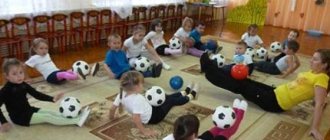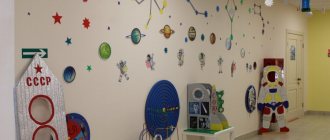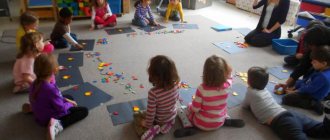Creative research project with children of the 2nd junior group on the topic “Birds are our friends”
MADOOU TsRR No. 86 “Oyuna” - kindergarten
Creative research project with children of the 2nd junior group on the topic
"Birds are our friends"
Educator: Borisova Tatyana Vasilievna
Ulan - Ude
2019
Target:
Expand and generalize children's knowledge about birds through various activities.
Tasks:
1. Give children an idea of domestic and wild birds, their characteristic features.
2. Reinforce the concept that domestic birds live next to humans, and wild birds live in the wild (in the forest, in the field).
3. Instill in children a caring attitude towards birds and respect for nature. Encourage children to independently carry out basic tasks (feeding birds).
4. Create conditions for the development of cognitive interest in children.
5. Involve children, parents, and teachers in joint activities.
6. Develop coherent speech and enrich children’s vocabulary.
7. To develop children’s interest in making birds using various materials.
Project Implementation Plan
Types of children's activities:
Speech development.
Conversations, situations on the topics: “A swallow came to visit us”, “How a sparrow settled in a starling’s house”, “Why a tit and a bullfinch flew from the forest to the city”, “Dining room for birds”, “We make ecological feeders”, “ What did we feed the chickens at grandma’s?”, “Where did the chicken come from?”, “What did we do with the crumbs from the table,” “Where does the sparrow live?”
Fiction
.
Reading fairy tales: r.n. “The Cockerel and the Bean Seed”, K. Chukovsky “Chicken”. Reading the stories of Samuil Marshak: “Children in a Cage” (“Owls”, “Little Swan”), L.N. Tolstoy “Stories for Children”: “Varya had a Siskin...”, Daniil Kharms: “The Good Duck”, E. Charushin “Chicken”. Reading songs and nursery rhymes: “The swallows are all sleeping in their nests...”, “The Pigeon Song”, “Lyuli, Lyuli, Lyuli, the Ghouls Have Arrived”, “The Cockerel and His Family”.
Reading and memorizing poetry
.
E. Blaginina: “Hungry, cold, jackdaws, sparrows!”, “Good morning.” A. Barto: “Who Shouts,” “Magpie-Crow.” I. Tokmakova: “Ten birds are a flock, catch them, sing along…”, “Stork”. M. Klokova “White Geese”.
Health and physical development
.
Outdoor games:
“Sparrows and a car”, “Birds in nests”, “Sparrows and a cat”, “Owl”, “Catching birds on the fly”, “Crows and a dog”, “Birds and chicks”, “Geese-geese”, “Migration of birds” "," Mother hen and chicks "," Birds, one! Birds, two!
Gymnastics game:
Finger gymnastics
: “Like in our meadow, there is a cup of cottage cheese...”
Invigorating gymnastics
: “The birds have arrived.”
Didactic games:
Speech game
: "The duckling and the gosling."
Didactic exercise-game
: "Call the chicken"
Targeted bird watching walks.
Short-term project in the 2nd junior group. Wintering birds project (junior group) on the topic
Short-term project in the 2nd junior group. Wintering birds
Feed the birds in winter! Let flocks of people flock to your porch from all over, as if it were home. Their food is not rich. A handful of grain is needed, One handful - and they won’t be afraid of winter... A. Yashin Type of project: information-oriented Type of project: short-term, family, group Implementation period: from 01/30/2017 to 02/17/2017
Project participants: children of the second junior group, parents, teachers. Relevance of the project: In the cold season, wintering birds face vital questions: how to feed themselves. The available food is becoming significantly less, but the need for it is increasing. Sometimes natural food becomes practically unavailable, so many birds cannot survive the winter and die. The task of adults is to cultivate children's interest in our smaller friends - birds, the desire to learn new facts about their lives, take care of them, and rejoice in the knowledge that by sharing crumbs, you can save birds from death in winter. To give children basic knowledge about what to feed birds in winter. Project goal: To develop moral feelings in preschoolers through environmental education with access to productive activities. Creating optimal conditions for the development of creative activity and a positive emotional state in a child through the organization of joint cognitive and productive work activities. Problems: Lack of children's knowledge about wintering birds. There is no skill in feeding birds in the winter season. Project objectives: Educational: • To consolidate the previously acquired knowledge of preschoolers about wintering birds, their way of life, habits, connections with the environment, the role of humans in the lives of birds. • Replenish existing knowledge with new information. • Teach children how to properly feed birds. Developmental: • Promote the development of cognitive and creative activity, curiosity. • Expand children's horizons and enrich their vocabulary, develop coherent speech. Educational: • Develop a caring attitude towards birds, a desire to help in difficult winter conditions. • Instill a love for nature and cultivate a caring attitude towards it. • Strengthen child-parent relationships Expected results of the project: - To interest children together with their parents in caring for birds, the desire to help them in the winter (making feeders, feeding birds in winter). — Joint activities will help strengthen parent-child relationships. — Development of curiosity, creativity, cognitive activity, and communication skills in children. Project stages: 1. Preparatory stage. — Determining the level of children’s knowledge about wintering birds. — Defining the project theme, objectives, strategies and mechanisms. — Collection of information on this topic. — Creation of the necessary conditions for the implementation of the project. 2. Main stage. Project implementation. It represents the introduction into the educational process of effective methods and techniques to expand the knowledge of preschoolers about wintering birds, their habits, and the characteristics of life in winter. The project was carried out in three directions: - work of teachers with children; - independent activity of children; - joint activities of parents and children.
Working with children to solve project problems:
1. Work of teachers with children Conversations: “What do you know about wintering birds?” Purpose: To identify the level of children’s knowledge about wintering birds. “Birds Menu” Purpose: To introduce children to the types of feeding birds in winter. “Winter Guests” Purpose: To expand children’s understanding of wintering birds. “Why help birds in winter” Purpose. To foster a caring attitude towards living nature. Examination of wintering birds in illustrations in books and magazines. Purpose: To clarify ideas about wintering birds, To activate children’s vocabulary. Examination of narrative paintings and photographs Purpose: To clarify ideas about wintering birds. Activate children's vocabulary. Compilation of stories based on illustrations Goal: Enrich and activate children's vocabulary. Form coherent speech. Learning poetry Goal: To teach listening to a literary text, to develop memory. Activate and enrich children's vocabulary. Learning finger games Goal: To develop hand motor skills. Activate children's vocabulary. Reading fiction (folklore, poetry, stories) Purpose: To develop interest in the need for reading. Involvement in familiarization with various forms of fiction. V. Zvyagina “Sparrow”, S. A. Yesenin “Winter Sings, Calls”, T. Evdoshenko “Take Care of the Birds”, “Winter Guests” Y. Nikonov “Sparrow”, “Where the Sparrow Dined” / from the series “Children in a Cage” ”, “Smart Bird”.Designing a corner of a book (selection of books about birds) Purpose: To expand children’s understanding of wintering birds, their characteristics, habits. Cultivating a love for feathered friends. Listening to the audio recording “Voices of the Winter Forest” Purpose: To learn to listen to music, to distinguish the voices of birds. Didactic games “Collect a bird”, “What kind of bird? ”, “Who is screaming?”, “Cut pictures”, “Whose shadow?”, “Small - small - less”, “Guess by touch”, “Who is further, who is closer?”, “Who is sitting where?” , “Guess who’s missing?”, “Feed the birds.” Goal: development of completeness of visual perception, the ability to systematically and purposefully examine an object, highlight the main features, and put together a whole picture from parts. Role-playing games “Invite the titmouse to visit”, “Bird Hospital” Purpose: To cultivate a desire to empathize and help feathered friends. 2. Independent activity of children: Examination of wintering birds in illustrations in books and magazines Examination of plot paintings and photographs Purpose: Clarify ideas about wintering birds. Activate children's vocabulary. Printed board games, insert games, cut-out pictures, stencils Purpose: Attracting children to independent activities. Walks: Bird watching. Bird tracks. Conversations about wintering birds. Outdoor games • “Crows” • “Birds” • “Sparrows and the cat”
Excursion around the territory of the kindergarten Opening of the “Bird Canteen” Purpose: To develop a caring attitude towards birds, a love for wildlife and a desire to take care of birds; strengthening parent-child relationships. Feeding birds Goal: To create a desire to take care of our feathered friends. 3. Joint activities of parents and children Competition “Bird's Dining Room” Goal: Involving parents to participate in the project, strengthening parent-child relationships. Education of moral feelings. Collecting food for birds Goal: To attract parents to the problem of feeding birds in winter. Strengthening parent-child relationships.
As a result of the work, children will receive a lot of new information about the birds that winter near us. They learn about the life of birds, their differences, habits, and habitat features in winter. Find out what you can feed birds and what you can’t. They will take part in collecting food for birds. Together with parents they will make feeders. Parent-child relationships will be strengthened. But the main result of the project is that children will learn that our feathered friends will not be able to survive the winter if we do not help them. Children will become kinder and more responsive.
Short-term project in the 2nd junior group.
Wintering birds



